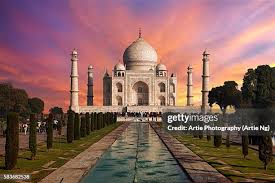Exploring the Taj Mahal: A Timeless Monument of Love

Introduction
The Taj Mahal, located in Agra, India, is one of the most recognisable symbols of love and architectural brilliance in the world. Built by Mughal Emperor Shah Jahan in memory of his beloved wife Mumtaz Mahal, this UNESCO World Heritage site attracts millions of visitors each year. Its intricate design and historical significance not only reflect the grandeur of Mughal architecture but also play an essential role in India’s cultural heritage and tourism.
Historical Background
Construction of the Taj Mahal began in 1632 and was completed in 1648, with some additional phases continuing until 1653. The monument is crafted from white marble, sourced from Makrana, and is adorned with elaborate carvings and inlay work featuring precious stones. The architecture combines elements from Islamic, Persian, Ottoman Turkish, and Indian styles, showcasing the cultural syncretism of the era.
Shah Jahan’s motivation for building the Taj Mahal was to honour Mumtaz Mahal, who died during childbirth. The mausoleum serves not only as a grave but as a tribute to their love. The legend surrounding the Taj Mahal’s construction states that Shah Jahan intended to build a second, identical black marble mausoleum across the river Yamuna, but this project was never realised due to his eventual imprisonment by his son Aurangzeb.
Current Status and Preservation
Today, the Taj Mahal is imperilled by pollution and environmental changes, leading to measures for its preservation. In 2018, the Indian government implemented restoration efforts, including cleaning the marble and regulating tourism to preserve the integrity of the monument. Additionally, awareness campaigns have been launched to reduce pollution levels in Agra, which threaten the Taj Mahal’s marble facade.
Tourist Experience
Visitors to the Taj Mahal can marvel at its grandeur and explore the extensive gardens that surround the monument. The complex features the main mausoleum, a mosque, and a guest house, all aligned symmetrically. Sunrise and sunset are particularly popular times to visit, as the changing light creates an ethereal atmosphere around the monument, accentuating its beauty.
Conclusion
The Taj Mahal remains a poignant symbol of love and an exquisite work of architectural art. As millions continue to visit it each year, the responsibility to protect and preserve this iconic landmark lies not only with local authorities but also with visitors who must respect and honour its historical significance. The future of the Taj Mahal is crucial, reflecting the shared heritage of humanity and the importance of safeguarding our cultural landmarks for generations to come.









